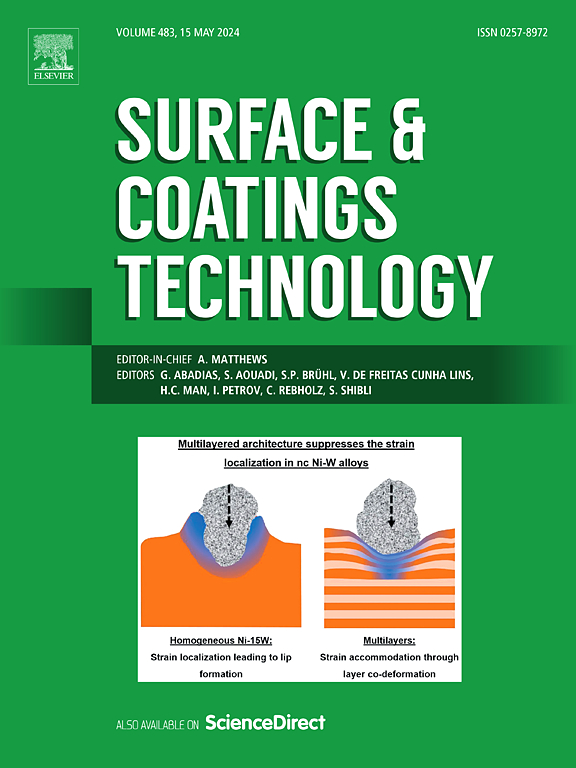Experimental analysis and modeling of sp2- and sp3-bonded phase formation during boron nitride film deposition by a reactive plasma-assisted coating method
IF 5.3
2区 材料科学
Q1 MATERIALS SCIENCE, COATINGS & FILMS
引用次数: 0
Abstract
Cubic boron nitride (c-BN) exhibits superior physical properties, making it highly suitable for various engineering applications. Despite their high potential, c-BN films adoption is hindered by the critical issue of delamination from the substrate. The structural transition region (STR) between the substrate and c-BN bulk film governs the delamination process because the STR suffers from residual strain and post-chemical reactions. Although the nucleation and growth of the sp3-bonded phase occur in the STR during the deposition of c-BN films, few models have been proposed for this mechanism. In this study, we formed c-BN films with various STR using a magnetically confined vacuum-arc plasma. The incident ion energies and metal impurity (W) concentrations were tuned using the process parameters to control the properties. The ion energy dependence addressed the presence of the threshold energy (Eth) for sp3-bond formation and Eth increased with higher W concentration (CW). The thickness of the STR increased with CW. Based on the experimental results, we proposed a model for the nucleation and growth dynamics of the sp3-bonded phase in the STR. The model predicted the suppression of the sp3-bonded phase growth by the introduction of W and an increase in Eth for sp3-bond formation. It also revealed the thickness dependence of the indentation hardness of c-BN films with various STR, that is CW values. The present results contribute to the process and functional design of c-BN films.
反应等离子体辅助镀膜法沉积氮化硼薄膜过程中sp2-和sp3键合相形成的实验分析和建模
立方氮化硼(c-BN)具有优异的物理性能,非常适合各种工程应用。尽管具有很高的潜力,但c-BN薄膜的采用受到衬底分层的关键问题的阻碍。衬底和c-BN体膜之间的结构过渡区(STR)受残余应变和后化学反应的影响,控制着分层过程。尽管在c-BN薄膜沉积过程中,STR中发生了sp3键合相的成核和生长,但关于这一机制的模型很少。在这项研究中,我们使用磁约束真空电弧等离子体制备了不同STR的c-BN薄膜。利用工艺参数调节入射离子能量和金属杂质(W)浓度来控制性能。离子能量依赖性解决了sp3键形成的阈值能量(Eth)的存在,Eth随着W浓度的增加而增加。随着连续流的增加,STR的厚度增加。基于实验结果,我们提出了sp3键相在STR中的成核和生长动力学模型,该模型预测了引入W和增加Eth对sp3键形成的抑制作用。同时还揭示了c-BN薄膜压痕硬度与不同STR (CW值)的厚度依赖性。本研究结果有助于c-BN薄膜的工艺和功能设计。
本文章由计算机程序翻译,如有差异,请以英文原文为准。
求助全文
约1分钟内获得全文
求助全文
来源期刊

Surface & Coatings Technology
工程技术-材料科学:膜
CiteScore
10.00
自引率
11.10%
发文量
921
审稿时长
19 days
期刊介绍:
Surface and Coatings Technology is an international archival journal publishing scientific papers on significant developments in surface and interface engineering to modify and improve the surface properties of materials for protection in demanding contact conditions or aggressive environments, or for enhanced functional performance. Contributions range from original scientific articles concerned with fundamental and applied aspects of research or direct applications of metallic, inorganic, organic and composite coatings, to invited reviews of current technology in specific areas. Papers submitted to this journal are expected to be in line with the following aspects in processes, and properties/performance:
A. Processes: Physical and chemical vapour deposition techniques, thermal and plasma spraying, surface modification by directed energy techniques such as ion, electron and laser beams, thermo-chemical treatment, wet chemical and electrochemical processes such as plating, sol-gel coating, anodization, plasma electrolytic oxidation, etc., but excluding painting.
B. Properties/performance: friction performance, wear resistance (e.g., abrasion, erosion, fretting, etc), corrosion and oxidation resistance, thermal protection, diffusion resistance, hydrophilicity/hydrophobicity, and properties relevant to smart materials behaviour and enhanced multifunctional performance for environmental, energy and medical applications, but excluding device aspects.
 求助内容:
求助内容: 应助结果提醒方式:
应助结果提醒方式:


